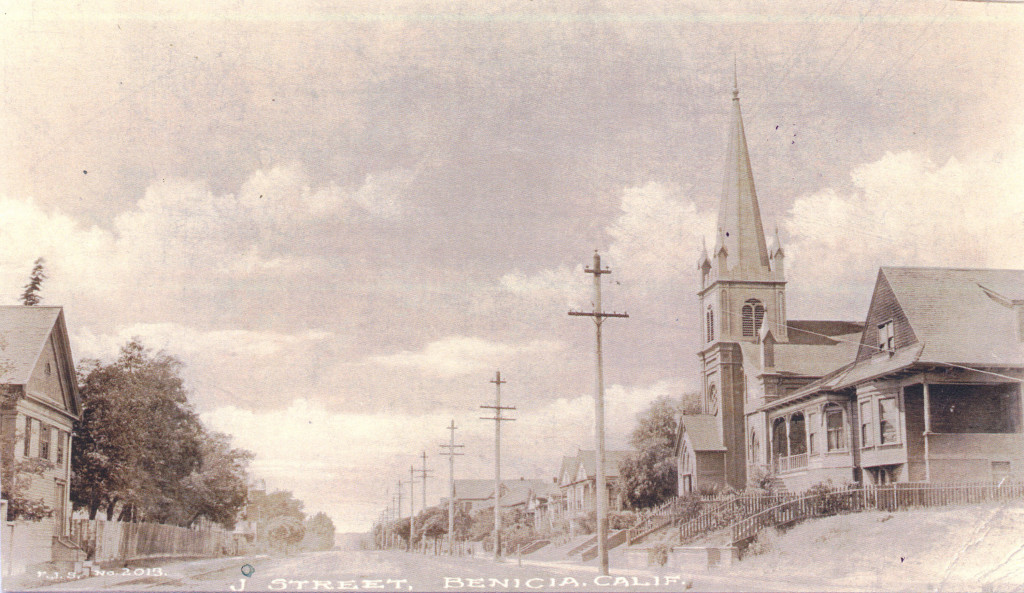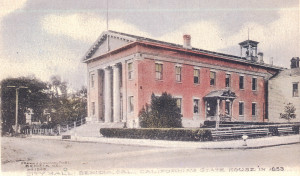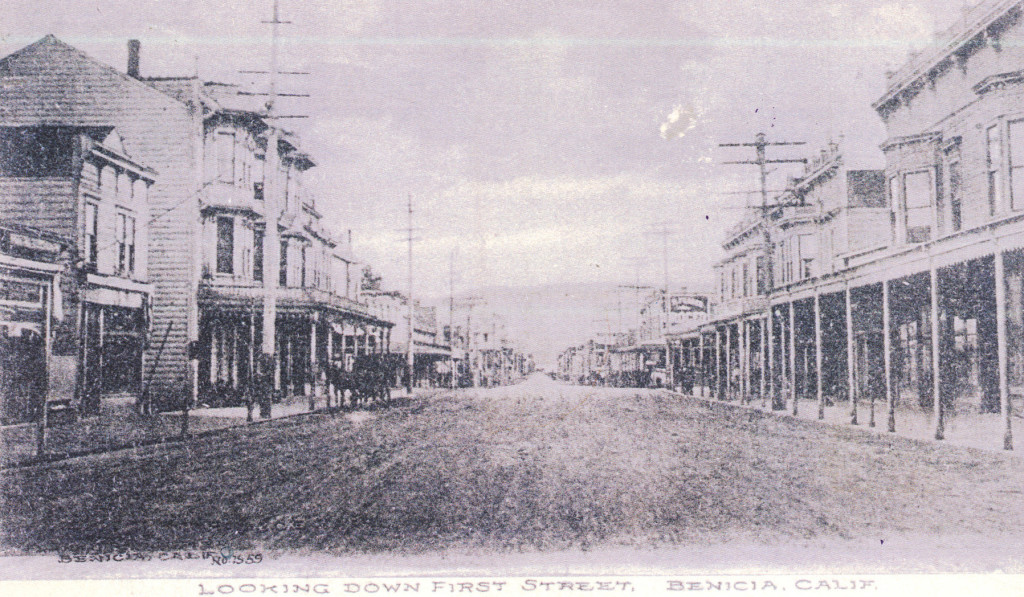
FRANK STUMM’S images of J Street, top, and the Capitol Building, then City Hall, below, are among many that will be displayed Sunday at the opening of a new exhibit at Benicia Historical Museum.
Images courtesy Benicia Historical Museum
Resident’s turn-of-the-century postcards highlighted in museum exhibit opening Sunday
A Benicia businessman, the son of a pioneering jeweler who opened his First Street business at the turn of the 19th century, didn’t let his father’s business interfere with his passion for photography, specifically picture postcards.
Frank Stumm’s passion for — and influence on — the popular collectible will be on display at Benicia Historical Museum beginning Sunday.
“Stumm’s Vintage Postcards — Views of Benicia and Beyond” is another of the museum’s exhibits focused on local personalities that need to be better known, said Elizabeth d’Huart, executive director.
“He was an interesting guy,” d’Huart said.
Frank’s father, F. J. Stumm, who moved to Benicia from Germany, opened the jewelry, high-end gifts and art store at 636 First St., a space now occupied by Bookshop Benicia. The Stumms installed the nearby outdoor clock and used its proximity in promoting their store.
Frank Stumm himself was brought up to carry on his father’s jewelry operation, which attracted shoppers from throughout the Bay Area. But the younger Stumm had another interest — photography. He introduced photographs to the store, then began publishing his pictures.
That led to having the photographs turned into postcards.
Collecting postcards was a growing hobby at the time, and d’Huart said interest in them hasn’t waned through the years. In fact, it’s the third most popular collectible, behind coins and postage stamps.
As Stumm took more and more pictures and had them printed as postcards, the images became distributed to collectors far beyond the Bay Area.
“Snapshots of Benicia introduced our city to the world,” d’Huart said.
Developing the exhibit has been a labor of love for Bob Kvasnicka and James Lessenger, d’Huart said.It began small — hearing stories from individuals, seeing images and photographs, and piecing together Stumm’s life, she said.
During that journey, Kvasnicka and Lessenger were able to share with museum staff the story of how Stumm’s passion for camerawork eventually became a business all its own.
“For me, I love objects,” d’Huart said. During the collecting of the 300 or so elements of the exhibit, she was able to examine and hold many original photographs.
“When I can hold an old photograph in my hand, and imagine I am standing in front of an old house — a house that probably isn’t there anymore — I get a jolt,” she said.
The pictures give the viewers a look at how Benicia and other areas appeared in the past, and a glimpse at an older way of life, d’Huart said.
“I am a curious person,” she said. Through its images, “this exhibit has allowed me to satisfy my curiosity.”
While much of the exhibit is devoted to the actual images, one way the museum broke up the collection of rectangular pictures was to call up the days in which the Stumm family operated their downtown business.
The museum did this by creating a mockup of the Stumm store, Kvasnicka said. Frank Stumm himself is depicted, “ready to help his next customer.”
Kvasnicka works in the archives department at the museum, and he and curator Beverly Phelan took images of the Stumm store photo and of Stumm himself to have them printed in the appropriate sizes, d’Huart said.
“Bob’s wife, Leslie, cut out the image of Frank to mount, and I have also wielded scissors to cut out the several hundred images to mount and frame,” she said.
She said they were aided by the California Department of Parks and Recreation and the Benicia Capitol State Historic Park in replicating the interior of the Stumm store.
“We also have on display the statue known as ‘Little Egypt,’ kindly loaned to us from the Fischer-Hanlon House,” she said.
That’s because some of Benicia’s historians believe the statue was purchased at the Stumm store, a contention supported by images of similar statues that were seen in pictures of the store.
In addition, the museum is introducing a crossword puzzle about the exhibit, Kvasnicka said. He created it, using an online application that often is used as a tool for educators.
“I’ve used this idea previously for parties and my wife has used it at work as a training tool. It’s a way to get people to learn about a topic while having fun. The idea seemed perfect for encouraging people to become more involved in the museum’s exhibits,” Kvasnicka said.
“While definitely not as difficult as the New York Times crossword, it should be an enjoyable way for people to learn about the Stumms and postcards in general.”
“Most of the clues relate to the Frank Stumm exhibit. A few are general-knowledge clues but most answers will be found in the displays and storyboards we’ve designed for the exhibit.”
Those submitting a winning entry that’s filled out with the correct answers (and who provide current contact information) will be in the running to receive the prize of a framed postcard image of their choice from the Stumm exhibit.
If more than three qualified entries are received, winners will be drawn from a box at the museum. Deadline to submit entries is July 6. The crossword will printed in Sunday’s Benicia Herald.
Board members have been busy getting the exhibit ready, d’Huart said, helping to bring the Stumm exhibit in after removing the previous exhibit on the Mizner family, another group of Benicia notables.
One board member, Larry Lauber, has assembled a video that visitors are able to view via a menu that breaks down postcard images by city.
Of course, the focus of the exhibit is the postcards, a majority of which are from an album put together by Ray Costa, who was born in Benicia and who worked at the Mare Island Naval Shipyard, d’Huart said.
Costa has several hundred Stumm postcards, many of which have been rarely seen, Kvasnicka said.
In preparation for the new show, Kvasnicka scanned hundreds of postcard images, and has done “an enormous amount of research, along with Jim Lessenger,” she said.
“The exhibit will also highlight Frank Stumm’s postcard publishing business and the hobby of postcard collecting,” Kvasnicka said.
“Frank Stumm published postcards of Benicia, Vallejo, Napa, Contra Costa, Fairfield, Suisun, San Francisco and even as far north as Lake County,” he said. “He did a wonderful job of capturing the North Bay in the early 1900s.”
Visitors to the exhibit will see hundreds of landscape portraits of Benicia, Martinez, Suisun, and the local area, d’Huart said.
In addition, they’ll view “exteriors of beautiful homes that have been torn down, and the interiors of several landmark buildings, some of which still stand, and others which have disappeared or been altered,” she said.
“The postcards were printed from 1904 to 1919, the year Stumm died from the flu pandemic.

FRANK STUMM took photos of more than his beloved Benicia; he also was on hand to chronicle the devastation wrought by the 1906 earthquake and fire in San Francisco.
Courtesy BHM
Not only will visitors see Stumm’s personal progress, they’ll also see the evolution of the postcard, Kvasnicka said.
“We learned that, originally, people could only write their message on the front of the card. The back was reserved for just the address,” he said.
“Also, the popularity of the postcard was immense during the ‘Golden Age’ of postcards, with over 50,000 sold by Frank Stumm in just one year, during 1905-1906.”
Visitors also will see what Kvasnicka called “the lavishness and variety of the merchandise carried by the Stumm store in the early part of the 1900s.
“The exhibit should appeal to people who love Benicia history, people interested in postcards and the photography related to producing them, postcard collecting, and those who just enjoy seeing how much Benicia and the North Bay has changed in almost 100 years,” Kvasnicka said.
“All in all, it is a fascinating look at the evolution of postcards and the man who introduced Benicia and Northern California to the rest of the world,” d’Huart said.
“I think visitors to the exhibit will be entertained and informed, whether their interest is in photography, history, architecture, the environment, or Benicia.”
The exhibit is opening with a special program that features postcard specialist Glen Koch, author of “San Francisco — Golden Age of Postcards,” who will address those attending.
Joel Fallon, Benicia’s first poet laureate, will open and close the program with two original poems, “both of which capture perfectly the power of old photos and the beauty of Benicia,” d’Huart said.
The exhibit opens at 1 p.m. Sunday at the Benicia Historical Museum, 2060 Camel Road, and the debut is open to the public at no cost. Refreshments will be served.
The museum is open from 1-4 p.m. Wednesdays through Sunday. Admission is $5 for adults, $3 for students and older people, and $2 for those 6 to 12. Admission is free the first Wednesday of the month, and to those with military ID and those 5 and younger.








Very nice article. I think that this exhibit will be something that people will remember for a very long time. They will see not only postcard-sized prints but larger photos of a bygone era. It is truly an invitation to step back in time.
I lived in Benicia for several years from 1982-2012. I found the city to be a jewel in more ways than one. The postcard exhibit is one I would love to see if I were closer. I am writing because I have several post cards from a collection that was given to me. Mostly of old warships, but some are of the San Francisco earthquake and the Portola festival. I would be happy to send a copy of any if they are interesting to you for your exhibit.